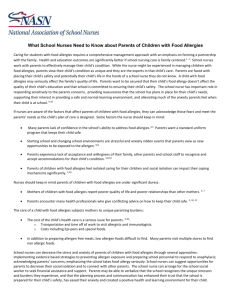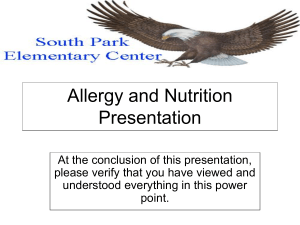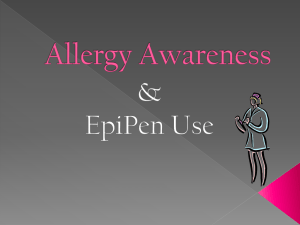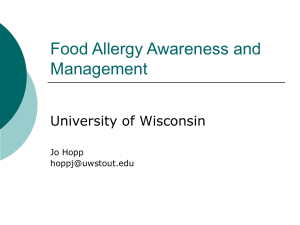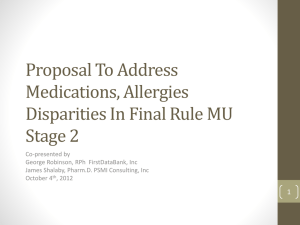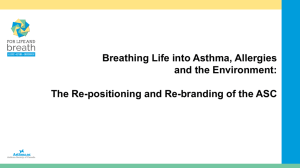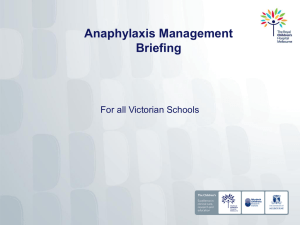Meeting Special Dietary Needs in Child Nutrition Programs
advertisement
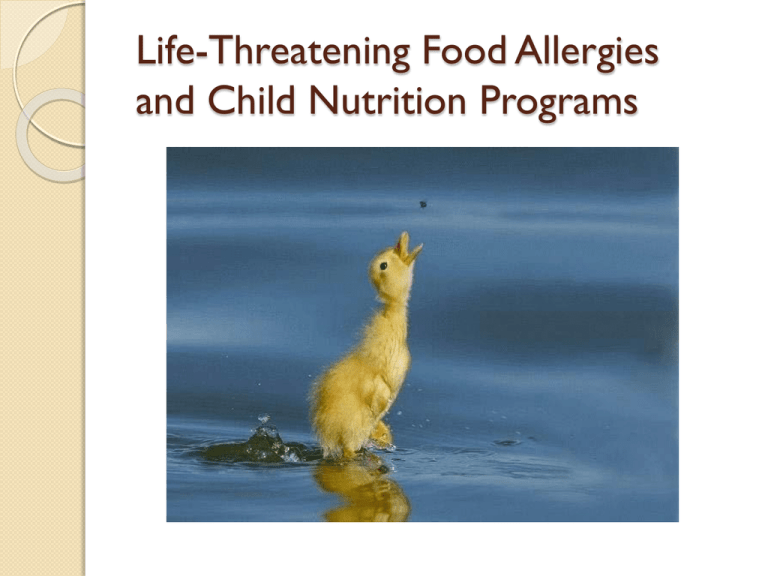
Life-Threatening Food Allergies and Child Nutrition Programs Objective To identify requirements, resources, and ideas for meeting the needs of children with lifethreatening food allergies. Laws and Regulations Rehabilitation Act of 1973 Individuals with Disabilities Education Act (IDEA) Americans with Disabilities Act (ADA) U.S. Department of Agriculture's (USDA) nondiscrimination regulation (7 CFR 15b) FNS Instruction 783-2, Revision 2, Meal Substitutions for Medical or Other Special Dietary Reasons What is the definition of Disability? A condition that substantially limits one or more major life activities; or A record of such a condition; or Being regarded as having such a condition. EATING is a major life activity that can be substantially limited by celiac disease. BREATHING can be impacted by food intolerances and food allergies. IDEA Disability Special education needed IEP completed Accommodations made Section 504 Disability Special education not needed 504 plan completed Accommodations made 5 Laws and Regulations Rehabilitation Act of 1973 Individuals with Disabilities Education Act (IDEA) Americans with Disabilities Act (ADA) U.S. Department of Agriculture's (USDA) nondiscrimination regulation (7 CFR 15b) FNS Instruction 783-2, Revision 2, Meal Substitutions for Medical or Other Special Dietary Reasons School Requirements for Children with Disabilities Accommodation MUST be made A disability determination can only be made by a licensed physician (or other recognized medical authority) No extra charge In the most integrated setting appropriate Required Statement For Children With Disabilities Signed by a licensed physician Identify the disability How it restricts diet Major life activity affected Foods to be omitted Foods to be substituted USDA Regulations and Guidance Child with medical conditions that are NOT disabilities are encouraged, but not required, to be accommodated. Some needs can be met through OvS. 9 Statement For Children Who Are Not Disabled Substitutions for non-disabled students must be supported by a statement signed by a recognized medical authority such as: physicians, physician assistants, nurse practitioner, other professionals specified by the State agency. Statement For Children Who Are Not Disabled (continued) Identify the medical condition or special dietary need How it restricts diet Foods to be omitted Foods to be substituted Nonacademic Services 7 CFR 15b.26 Students with disabilities MUST have an equal opportunity to participate in nonacademic and extracurricular services. Examples: physical education and athletics, food services, transportation, health services, recreational activities, special interest groups or clubs sponsored by the recipient. Classroom activities such as parties would fall under this regulation. THESE THINGS DO NOT NECESSARILY INVOLVE THE FOOD SERVICE STAFF, BUT SOMEONE AT THE SCHOOL NEEDS TO ADDRESS THESE Food Allergy Awareness Protocol Common Food Allergies • • • • • • • • peanuts tree nuts (such as almonds, pecans, walnuts) milk eggs soy wheat fish (such as bass, cod, flounder) crustacean shellfish (such as crab, lobster, shrimp) 15 Food Allergies Definition Symptoms Anaphylaxis Symptoms of Anaphylaxis Anaphylaxis Reaction time Most dangerous symptoms Treatment for Allergies Antihistamines/Bronchodilators Epinephrine Prevention and Strict Avoidance Food Intolerance Definition: Food intolerance is an adverse reaction to food that does not involve the immune system. Example ◦ Lactose Intolerance Regulations Accommodations Required Accommodations with Approval of Food Service Dir. ◦ Allergies with the potential of anaphylaxis ◦ Allergies with no anaphylaxis ◦ Celiac disease ◦ Food intolerances Food Allergy Awareness Protocol Purpose ◦ Establish a building-based general Medical Emergency Plan. ◦ Develop and implement an Individual Health Care Plan for students with diagnosed lifethreatening allergies. ◦ Implement annual life-threatening allergy and epi-pen training for appropriate staff. ◦ Restrict and/or control the use of food during the school day. Parent/Guardian Responsibility Notify the school nurse or principal prior to the opening of school each year. Have doctor complete the necessary forms for foodservice prior to each year. Deliver/provide approved medications to school nurse and replace when expired. Meet with school nurse and other school staff to develop an IHCP and mode for communication. School Administrator Responsibility Establish a basic Medical Emergency Plan for the building for use in any medical emergency. Ensure that an IHCP for each child with a life-threatening allergy is created and implemented. Establish a procedure for how and when school staff should communicate. School Nurse Responsibility Develop an IHCP, corresponding Allergy Action Plan and Medication Administration Plan with parents/guardians and school team. Arrange for periodic review of IHCP at least annually. Provide education and training to all need-to-know school staff. Food Services Responsibilities Attend training if required by IHCP. Follow safe food handling practices to avoid cross contamination. Follow cleaning and sanitation protocol to avoid cross contamination. With parent approval, set up procedures for cafeteria. After receiving the approved statement, make reasonable meal accommodations. Food Service Assistants Preventing exposure to allergens starts in the kitchen. • Read food labels. • Know what to avoid and how to substitute. • Designate allergy-free zones in the kitchen. • Follow safe food handling practices. 30 www.foodallergy.org Food Service Assistants Understand the allergy plan. Identify the students with documented food allergies. Learn to recognize signs of anaphylaxis, and know how to activate the school’s emergency plan. Cafeteria Host/Custodial Responsibilities Attend training according to the student’s IHCP. Following safe food handling practices and cleaning and sanitation protocol to avoid cross-contamination. Provide a clearly labeled allergen free table for students if required by an IHCP. Respond appropriately to all complaints/concerns. Peanut Free vs. Peanut Aware? Students’ Responsibility Do not trade food with others. Wash hands before and after eating. Do not eat anything with unknown ingredients or known allergen. Be proactive in the care and management of their food allergies and reactions. Notify an adult immediately if they eat something they believe to contain the allergen, and/or if they are having symptoms. Transportation Staff Responsibility Provide a representative for school team meetings to discuss IHCP as appropriate. Provide annual training for all school bus drivers on managing life-threatening allergies. Provide functioning emergency communication device. Know how to activate EMS. Maintain policy of not permitting food to be eaten on school buses. Meeting the Needs of All Other Examples of DietRelated Disabilities Diabetes Severe Food Allergies (anaphylaxis) Celiac Disease Phenylketonuria (PKU), other metabolic Epilepsy Emotional illness Heart disease Autism Accommodations Use food already purchased when possible May require special training May require professional help of a dietitian State agencies may be of assistance 39 Diet Restrictions can be hard… Recipe Ideas… Specialty Foods Accommodating Children with Special Dietary Needs in the School Nutrition Programs: Incurring Additional Expenses; Potential Funding Sources School District’s General Fund Individuals with Disabilities Education Act (IDEA) Medicaid Supplemental Security Income (SSI) Food Service Assistants • Maintain communication among parents, teacher, school nurse, food service, and consultant if needed • Understand the dietary restrictions prescribed in the plan kept on file with the school nurse • Obtain and serve special formula or foods • Follow prescribed portion sizes • Report mistakes immediately • Keep information confidential 44 Practical Applications Baked chicken and baked potato or steamed veggie with chicken and rice for someone who has celiac disease. The meal does not have to be exactly the same as what is provided to others. Allergy Scenarios: Janet is making cookies for school lunch. Since there are a few students with life threatening peanut allergies, she is making peanut butter cookies and sugar cookies. When the cookies are finished baking, she uses a spatula to place the peanut butter cookies on one serving tray and the same spatula to place the sugar cookies on a separate tray. During serving, Janet puts on a pair of gloves and serves the students their choice of cookie as they pass through the line. She identifies the students with peanut allergies and serves them only sugar cookies. Alice is making ham and cheese sandwiches for school lunch. She first slices the cheese on the slicer and then slices the ham. She first makes the ham and cheese sandwiches, and then because there is a student with milk allergies, she changes her gloves and makes ham-only sandwiches. Tom is making peanut butter and jelly sandwiches for lunch. When he finishes preparing the peanut butter and jelly sandwiches, he wipes off his knife and then takes the knife, the jelly, and the bread over to the kitchen’s allergy-free zone and makes the jelly sandwiches for the students with peanut allergies. The cafeteria received a new shipment of hotdogs for school lunch. Shirley has served hotdogs several times to the students with milk allergies, so she does not read the label when she takes the hotdogs out of the packaging. Shirley then throws away the packaging. She prepares the hotdogs and puts them on the serving line. Peter is taking out the milk to put it on the line for lunch. He realizes that the cafeteria is out of soy milk, which is usually served to the two students who have milk allergies. The list of appropriate substitutions for these students states to use soy milk or rice milk in place of cow’s milk. Peter decides that these students will probably be fine with lactose free milk as well, so he puts that on the line for them to take. Obstacles are opportunities to expand our resourcefulness. More Resources… More Resources… THANK YOU!!!
